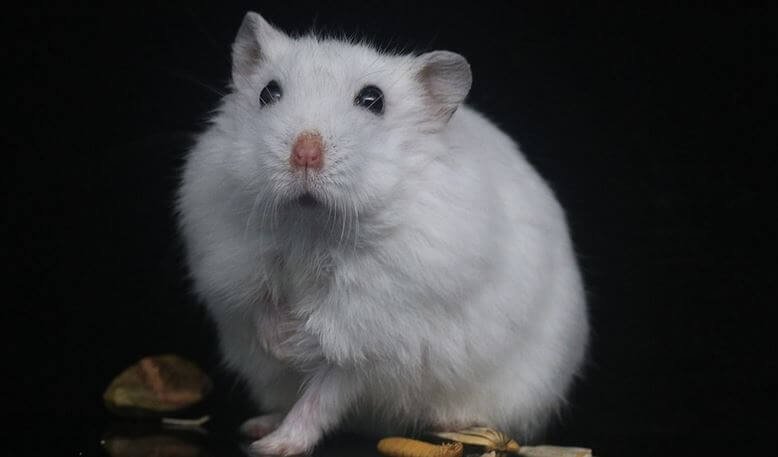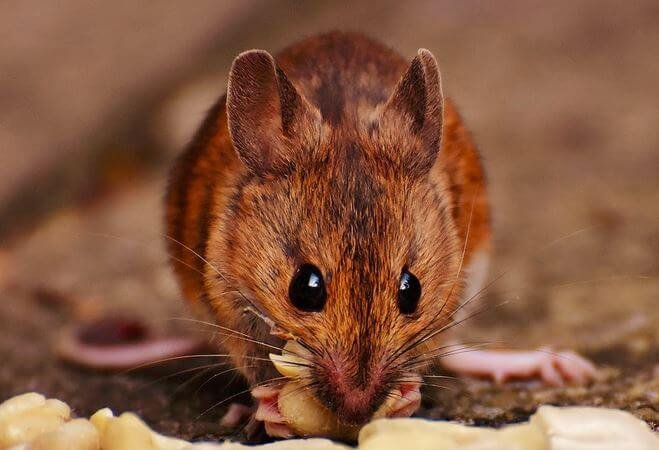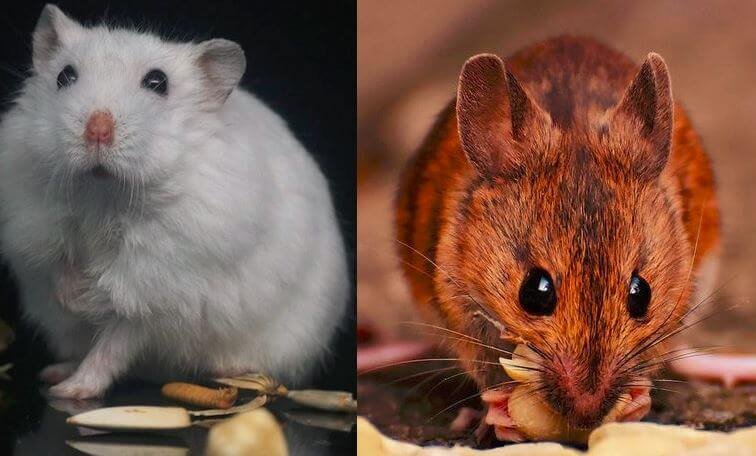Nothing strikes a perfect resemblance like a hamster and a rat. And it’s not uncommon for people to confuse them. Still and all, is a hamster a rat?
A hamster is not a rat, even though the two animals originate from the order Rodentia. According to biology, hamsters belong to the Cricetinae subfamily, and rats come from the Murinae subfamily. Hamsters are generally smaller than rats and have shorter, stubby tails.
If you have seen human doppelgangers before, hamsters and rats form such a pair. Let’s review the similarities and differences between these rodents in this article, and you’ll know why the two are not the same.
What Is a Hamster?

The superfamily Muridae houses both hamsters and rats under the same roof. However, hamsters are members of the Cricetinae subfamily, with an internal cheek pouch.
Physical Appearance
Hamsters feature stout bodies with short tails. They have short snouts, small ears, and short legs furnished with large feet.
Kept as house pets, hamsters are rich in color and patterns. They range from black, brown, red, grey, white, yellow, or a combination of these colors.
The Universities Federation for Animal Welfare reveals 24 hamster species. Coming in various sizes, hamsters can be as large as the European breeds, which grow up to 12.5 inches or 32 centimeters.
Then you have the dwarf species of hamsters. These can grow only 2-4 inches or 5.5 to 10.5 centimeters in length.
Among the 24 species, pet owners have found the Syrian hamster (teddy bear hamster or golden hamster) most appealing for petting. This hamster is not among the biggest varieties – usually growing up to 6 inches or 15.24 cm long.
Habitat
To better understand the biology of hamsters, it’s essential to learn about their habitats. Generally, hamsters originated in Syria. They also find suitable habitats in:
- Greece
- Romania
- Belgium
- Siberia
- Mongolia
- Korea, and China.
Since hamsters do not hibernate during winter, they can live in different habitats. Habitat flexibility is also charged because these rodents come in many species.
Hamsters can inhabit the dry open country, desert borders, river valleys, mountain steppes, cultivated crops, and vegetated sand dunes.
Zoologist Israel Aharoni worked out to introduce hamsters in the U.S. and the U.K. In the 1930s, Aharoni successfully bred four hamsters he had brought from Syria to Jerusalem’s Hebrew University.
He then distributed the offspring to universities and other research institutions in the United States and the United Kingdom. By mid-1940, hamsters had spread across these regions as some of the best pets for households.
Also Read: Why Do Hamsters Die So Easily? Here’s Why and What to Do
Hamster Behavior and Habits
Like many of their relatives, hamsters are nocturnal–sleeping during the day and active at night, including early morning and late evening. Since they are excellent diggers, hamsters burrow underground while in the wild.
The burrows could feature one or two entrances and chambers for food storage, breeding, and other activities. When temperatures are extremely hot, especially in desert or dry land habitats, the burrows help to cool these animals.
Some hamsters also use tunnels created by other mammals, such as the pika. They simply improve them to their liking and live there.
Most hamsters don’t hibernate in winter, although some species can get into a short torpor period of inactivity that lasts from a few days to several weeks.
Syrian hamsters are excellent pets in the household. They are gentle and straightforward to handle. But you don’t want to cage them with other hamsters because they are extremely territorial. They will fight off their adversaries to death.
However, dwarf species are kind and friendly. They don’t mind having company around them.
When threatened, these animals will bite. Don’t wake them up while they sleep, as you risk being bitten.
The rodents have special scent glands that secrete a certain smell. Since they have a poor sight, they rely on the smell they release on the path and objects to find the way back home.
Hamster Diet
Hamsters love feeding on whole grains, nuts, and seeds. They can diversify into fruits, vegetables, invertebrates, and small crawling insects.
For a domesticated hamster, make sure you provide a well-balanced diet. You should offer seeds and grains in small quantities. Balance that with pellets and rodent blocks.
According to Dr. Gregory Rich of Avian and Exotic Animal Hospital of Louisiana, “Hamsters do well on a mixture of pellets and a small amount of seeds, grains, or piece of nuts.” He tells Dodo.
While in the wild, hamsters carry food in their cheek pouches to store for later use. And this is the reason they are called hamsters.
What Is a Rat?

Rats are from the order Rodentia. They also originate from the superfamily Muridae. House rats are known for their destructive nature, from eating in food stores to contaminating grains and even killing poultry.
They also spread disease.
Physical Appearance
Rats are generally larger than hamsters, measuring an average of 6.7-8.3 inches or 17-21 centimeters long. They are primarily thin-tailed, with the tail longer than the body.
Outfitted with slender bodies, rats feature a pointed head with an extended snout. They have relatively more prominent ears that are furred.
Their legs are long with sharp claws adapted to burrowing. Tails can be short or longer than the body and are covered with less hair or may be bald. Most species also come with a short, soft, and dense coat.
Habitats
While some rats are okay living in burrows they made underground in forests, others find solace in the nests they build in trees or rotting tree trunks. Rats also build nests in rock crevices as long as these areas provide good privacy.
House rats, on the other hand, want to dwell among humans. You’ll find them in small rural houses and large city buildings.
Habits
Rats prefer living in groups and sleeping together in one shelter. Being sociable, house rats seek to live in homes, but they are extremely destructive.
Just like the Syrian hamster, rats are very territorial. If an unfamiliar rat comes by, there will be a fight. They also love grooming one another.
Diet
A rat’s diet varies depending on the species and its habitat. The rats living in rainforests (Sulawesian white-tailed rat and Hoffman’s rat) mainly feed on fruits and seeds. Others in the same habitats eat insects and worms.
The omnivorous brown rat can have a wide diet. It can eat anything from shrimp, snails, and mussels to insects and bird eggs.
House rats, on the other hand, feast on grains stored by humans. They may also scavenge kitchen waste in the backyard.
Hamsters Vs. Rats: What Is the difference?
The following table compares hamsters and rats based on their features:
| Features | Hamsters | Rats |
| Physical appearance | Hamsters exist in many colors and patterns. They have short snouts, short legs, and more fur on the coat. | Long slender bodies with a long snout and relatively long ears. Come in solid colors like grey, brown, white, or black. |
| Size | They are about 5 inches or 12 cm long with short tails. Weight is about 3-8 ounces. | About 6-8 inches long with a long tail. It could weigh 3-10 ounces. |
| Habitat | Hamsters live in underground burrows in the wild. You can find them in sand dunes, deserts, plateaus, river valleys, and mountain steppes. | Live in many places, including rainforest surfaces, rock crevices, caves, and among humans in village huts and large city buildings. |
| Diet | Mainly grains, seeds, and nuts. But can also feed on vegetables, fruits, and insects. Some wild species enjoy small frogs, worms, and slugs. | Diet varies with species and where they live. Could use grains, nuts, worms, snails, insects, and bird eggs. |
| Habits and behavior | The Syrian hamster is territorial and uncomfortable in the presence of other hamsters. They are nocturnal. | They are friendly and destructive. May not tolerate unfamiliar neighbors and rats. They enjoy being in a group and even sleeping together. |
Final Thoughts
While hamsters and rats may look similar at first glance, biology tells us they are two distinct species.
Although they may share some similarities in behavior and physical characteristics, the genetic and evolutionary differences make them separate animals.
So, the next time someone asks you, “Is a hamster a rat?” you can confidently answer with a resounding no, knowing these tiny furry creatures belong to different species.

